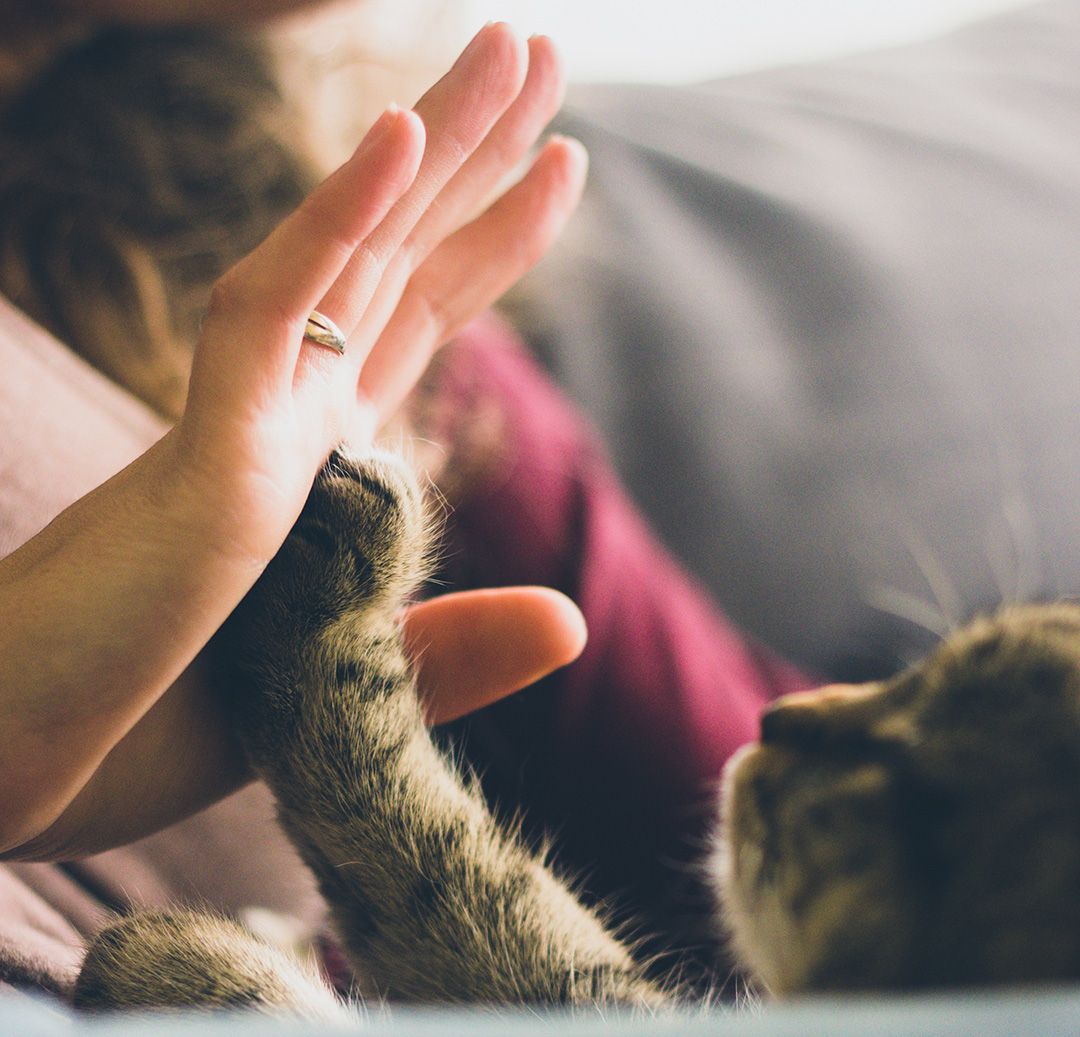I just finished an anthropology book "The Secret of Our Success" by Joseph Henrich. His claim was this. We, humans, are not smarter than chimpanzee because of our rational thinking. We are smarter because of our ability to identify the prestigious man and successfully imitate him.
It was an interesting concept I thought. There are many negative stigmas around copying other people as something against our originality. But our whole humanity relies on that ability.
This concept applies to dancing as well. The quickest path to learn dancing is to find a good dancer and imitate his move successfully. It is especially true if you are just starting out.
No one can write a book without first building your vocabularies to express your thought.
So today, I will talk about how to identify a successful dancer and copy him well.
Creativity Myth
The biggest fear of copying someone else is other people finding that out. They will call you fake and unauthentic. But that is not true for 3 reasons.
- Performance Art is Never the Same
- Break down into the Subsets
- You are a Curator
Performance Art is Never the Same
Dance is a performance art. Unlike Olympic skating, there are no predetermined scores for each move.
The move A does not imply impression B.
There are so many factors involved in the process of forming audience impression. They can come from your facial expression, the length of your legs, the song you're dancing on, the mood of your performance clothes, etc.
The bottom line is no matter how well you copy another dancer, your performance will never be the same.
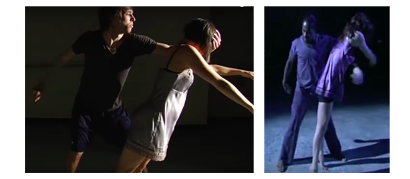
(Source: Wade Robson)
Breakdown into the Subsets
How many dance move can you recall? As far as I know, Michael Jackson's moonwalk or MC hammers running man. Sure, you can copy those moves as much as you want. Everyone recognizes that, and it is good in its own sense to cheer the crowds. For all the other moves, you will not be able to copy the entire move of someone else's from the bottom to top.
What you will end up is a subset of moves from that person. You will end up configuring the copying and mixing the moves at your own taste regardless.
Imagine you are copying not only from 1 but 3 at the same time. You combine the best of the 3 dancers. At the end of the day, you will come up with your own combination of moves. That's the power of creativity.
You are a Curator
When I was in school, I had a summer job at an art gallery. My boss was an artist as well as a curator. His job was to implement select art pieces and change the interior decoration to give the exhibition a theme. Up until that point, I always thought art is only about the creator. But that was my new insight into creativity.
Dancing is similar. There are many existing moves, but your job is to put them all into one coherent piece for that music. That will become your originality.
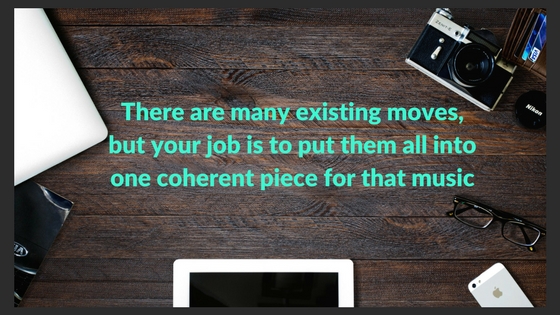
7 Ways to Copycat a Dancer
1. Leverage the Video
You might think of learning to dance equals to going to a class or finding a teacher. That is not a wrong approach. But videos are such powerful tools, you should definitely use it.
The biggest advantage of YouTube videos over actual people you can pose and watch it over and over. It's not to mention you can find a dancer of your favorite style from all around the world. In a big international event, most organizer employes a professional videographer nowadays. You should be able to find any dancer who is active in the scene easily.
For more on this topic from the lesson perspective, read my previous article on "Use YouTube videos to your advantage".
2. Follow Dancers Not Genres
When you search "locking" on youtube, the top result comes up with the video by Urban Dance Camp. If you look at the side, you will notice that the recommendations are all from videos uploaded by Urban Dance Camp. They have many quality performance videos, but it is important to take a notice of the performers themselves. Since most videos are uploaded by the studio production, not by the dancers, dancers become pushed out from the YouTube algorithm suggestions.
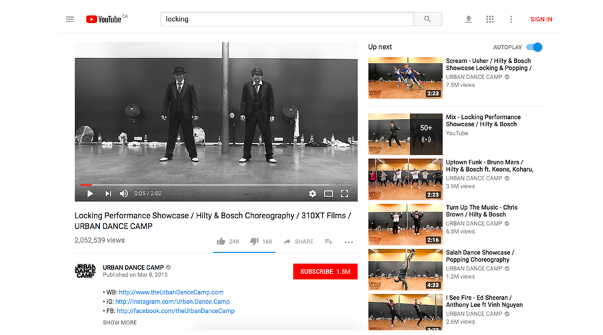
Usually, in the title or in the description, video uploaders give credits to the performers. In this case, that is Hilty and Bosch. Now, it is time to search them. The search results show more than 100,000. This second video dates 11 years ago!
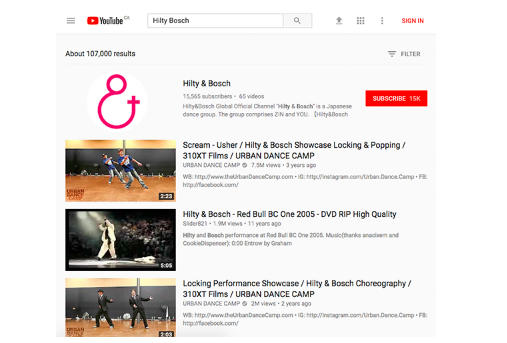
The videos don't need to be the latest. In fact, you will find it easier to follow the old videos where those dancers were already great yet still clumsy compared to the ones now. It is as long as the quality is high enough to see the detail (I prefer ones with minimum 480px quality).
3. Name Each Move
You cannot imitate all moves at once. Identify the subset of his moves and learn. A good rule of thumb is 3 seconds. Yes, it is this short. Dance performance is a combination of complex moves. That time frame is enough to isolate the subset to practice on.
If it is a famous dance step, you can name it so. If there is a unique twist the dancer is adding to, you say it like "Hilty's toplock" for example.
You will expand the repertoires faster from identifying which moves you can do and cannot do. It will become your new mental mindmap. It will also help you from not getting into the pitfall of over repeating yourself unconsciously.
Write down the time of the video as well. You will be able to easily reference back later.
4. Write Down Methods on a Paper
Our default mode of media interaction is passive consumption. We just like to sit back and relax. Once it sucks you in, you are gone forever. That is why separate videos from the physical practice as much as possible.
This is a technique people use at a workout. They bring a check sheet to complete a set. Imagine you have to check the how-to videos on your smartphones every 10 push-ups? It will take forever to complete the set.
Double checking the video for the specific move is ok. But in my experience, there are too many distractions on the YouTube. On top of that, you are already exhausted and there is so much excuse to sit around. You will end up not practicing at all.
In order to avoid, bring down a piece of paper with the names of moves you are trying to practice to the dance floor. You will be able to review them thoroughly instead of relying on your memory.
5. Find a Reflection
You feel so great watching videos. It feels like you have learned so much.
But that doesn't mean you have mastered the move. Visualization is not enough. Use a mirror for the quick feedback. You will notice the gap in your reflection and what you see in your head. Another method to confirm your move is filming. It is rather tedious. But this is 10 times better than nothing.
By seeing yourself, you will pick up the fine vibe and groove that the dancer employs.
Nothing is stopping you from experimenting. If the dancer is performing with the left hand, try it with the right.
6. Swap the Music
You should start with no music. Just count. Only when you get comfortable with the move, put on the original song. You might be surprised how fast the routine goes. There is no need to panic. Be patient and feel free to go back without the music and slowly pick up the pace.
In the next step, put on a different song and try out the move. If you can do it both fast and slow, you have internalized the mechanism of the movement with your own feeling. The move is now yours.
7. Play Pictionary
Have you played a game Pictionary? Your friend draws a picture and you're supposed to guess what it is.
If you have a group of dance friends with the same genre or passion, you can play this game. You make the move, and your friends guess who that is. If they get it wrong, that's ok. You can explain the move, show the video, and figure out the difference together.
That is a proper learning process. It's good for the motivation as well.
Enjoy your next dance pictionary session:)
What it means to be a Successful Dancer
There is a difference between dancing and random move. No one should be scared of making the wrong move or looking stupid. But there are many "originality advocates" in the improvised street dance scene. They do any move and call themselves "creative dancers". That is ridiculous.
An important distinction here is body awareness. Are you aware of how you look? Is it the same dancing as you have visualized it in your head? Are you happy with your own move? Those advocates never see their own dance and are only happy in their imaginary world.
Finding a good dancer whether he is real or virtual is the first step in learning. Only after that, you can start digesting his experience. By increasing your dance vocabulary, you will be able to create an astonishing performance. You will be happy and the audience will be happy. That is the true art of dancing.
